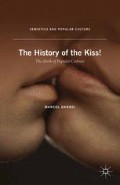Abstract
Music brings out the passions of love perhaps like no other art form, as the troubadours and other medieval composers certainly knew. In his Republic, Plato equates music with our need for beauty: “Thus much of music, and the ending is appropriate; for what should be the end of music if not the love of beauty?”1 One of the most passionate, romantic songs of the 1950s that evokes Plato’s “love of beauty” is sung by Louis Armstrong (among others). It is called the “Kiss of Fire.” The song casts an enormously powerful romantic spell over all those who hear it. Its first line says it all: “I touch your lips and all at once the sparks go flying.” In the conclusion, the song tells us, we must surrender to the “kiss of fire.”
Oh what lies lurk in kisses.
—Heinrich Heine (1797–1856)
Access this chapter
Tax calculation will be finalised at checkout
Purchases are for personal use only
Preview
Unable to display preview. Download preview PDF.
Notes
Plato, The Republic (New York: Sphere Books, 1986), p. 171.
Lewis Thomas, The Medusa and the Snail: More Notes of a Biology Watcher (London: Penguin, 1979), p. 87
For a comprehensive treatment of troubadour songs and poetry, see Simon Gaunt and Sarah Kay (eds.), The Troubadours: An Introduction (Cambridge: Cambridge University Press, 1999)
and Elizabeth Audrey, The Music of the Troubadours (Bloomington: Indiana University Press, 2000).
Dante Alighieri, De vulgari eloquentia, ed. Steven Botteril (Cambridge: Cambridge University Press, 2005).
Peter Dronke, The Medieval Lyric (Woodbridge: Boydell & Brewer, 1996), p. 111.
F. R. P. Akehurst and Judith M. Davis (eds.), A Handbook of the Troubadours (Berkeley: University of California Press, 1995), p. 23.
Works treating the history and importance of the troubadours to music and poetry include Frederick Morris Warren, “The Troubadour ‘Canso’ and Latin Lyric Poetry,” Modern Philology 9 (1912): 469–487;
H. J. Chayton, The Troubadours (Cambridge: Cambridge University press, 1912);
Roger Boase, The Origin and Meaning of Courtly Love (Manchester: Manchester University Press, 1977); and Gaunt and Kay, The Troubadours.
A comprehensive collection and analysis of the music of the Minnesingers is the one by Ronald J. Taylor, The Art of the Minnesinger: Songs of the Thirteenth Century (Cardiff: University of Wales Press, 1968).
Comprehensive treatments of the madrigal can be found in Alfred Einstein, The Italian Madrigal (Princeton: Princeton University Press, 1949)
and Iain Fenlon and James Haar, The Italian Madrigal in the 16th Century: Sources and Interpretation (Cambridge: Cambridge University Press, 1988).
see James Chatter, Luca Marenzio and the Italian Madrigal, 1577–1593 (Ann Arbor: University of Michigan Press, 1981).
Richard Wagner, Art and Politics, trans. William A. Ellis (Lincoln: University of Nebraska Press, 1995).
The role of Tin Pan Alley in the evolution of popular music is discussed by Isaac Goldberg, Tin Pan Alley: A Chronicle of American Music (New York: Frederick Ungar, 1930);
David A. Jasen, Tin Pan Alley: The Composers, the Songs, the Performers and Their Times (New York: Primus, 1988);
and Nicholas E. Tawa, The Way to Tin Pan Alley: American Popular Song, 1866–1910 (New York: Schirmer Books, 1990).
Lenny Kaye, You Call It Madness: The Sensuous Song of the Croon (New York: Villiard, 2004).
Good treatments of the rise and importance of popular to the constitution of popular culture include Ted Greenwald, Rock & Roll (New York: Friedman, 1992);
David P. Szatmary, A Time to Rock: A Social History of Rock ‘n’ Roll (New York: Schirmer Books, 1996);
Mark Gavreau Judge, If It Ain’t Got that Swing: The Rebirth of Grown-Up Culture (New York: Spence, 2000);
Cheryl L. Keyes, Rap Music and Street Consciousness (Urbana: University of Illinois Press, 2002);
Peter Blecha, Taboo Tunes: A History of Banned & Censored Songs (San Francisco: Backbeat, 2004);
and Simon Frith, Popular Music: Critical Concepts in Media and Cultural Studies (London: Routledge, 2004).
Robert Herrick, Hesperides (McMinnville, OR: Phillip J. Pirages Rare Books, 1648).
Kitty Ferguson, The Music of Pythagoras: How an Ancient Brotherhood Cracked the Code of the Universe and Lit the Path from Antiquity to Outer Space (New York: Walker and Company, 2008).
See also Jamie James, The Music of the Spheres: Music, Science, and the Natural Order of the Universe (New York: Springer, 1993).
See Theodor Adorno, Beethoven: The Philosophy of Music; Fragments and Texts (Cambridge: Polity Press, 1993).
Greil Marcus, Dead Elvis: A Chronicle of a Cultural Obsession (New York: Anchor Books, 1991), p. 18.
Author information
Authors and Affiliations
Copyright information
© 2013 Marcel Danesi
About this chapter
Cite this chapter
Danesi, M. (2013). The Kiss in Songs. In: The History of the Kiss!. Semiotics and Popular Culture. Palgrave Macmillan, New York. https://doi.org/10.1057/9781137376855_5
Download citation
DOI: https://doi.org/10.1057/9781137376855_5
Publisher Name: Palgrave Macmillan, New York
Print ISBN: 978-1-137-37684-8
Online ISBN: 978-1-137-37685-5
eBook Packages: Palgrave Media & Culture CollectionLiterature, Cultural and Media Studies (R0)

